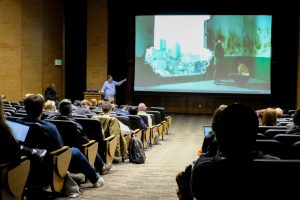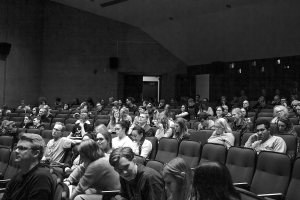
 Still Life (2006)–literally: Good People of the Three Gorges in the original Mandarin title–was the first big break for one of China’s most popular directors today, Jia Zhangke. In his IC lecture, Dr. Steve Riep (Department of Asian and Near Eastern Languages) explained that film historians use the term “generations” to define periods in Chinese film history. Jia, like the others of the sixth generation, often make underground or independent films and use digital photography and location shooting to facilitate their low budgets. They are also interested in real life subjects as Jia is in both his documentaries and his narrative features. His films are grounded in actual problems faced in the wake of China’s rapid modernization, and his social critiques focus on the alienation and disorientation stemming from environmental, demographic, and social change.
Still Life (2006)–literally: Good People of the Three Gorges in the original Mandarin title–was the first big break for one of China’s most popular directors today, Jia Zhangke. In his IC lecture, Dr. Steve Riep (Department of Asian and Near Eastern Languages) explained that film historians use the term “generations” to define periods in Chinese film history. Jia, like the others of the sixth generation, often make underground or independent films and use digital photography and location shooting to facilitate their low budgets. They are also interested in real life subjects as Jia is in both his documentaries and his narrative features. His films are grounded in actual problems faced in the wake of China’s rapid modernization, and his social critiques focus on the alienation and disorientation stemming from environmental, demographic, and social change.
Still Life is set against the backdrop of the construction of the Three Gorges Dam, the world’s largest power station, on the Yangtze river in Fengjie. The dam was a project first proposed by Sun Yat-sen in 1919, picked up by the nationals, then by the Japanese occupiers, then the Americans supporting the nationalist government, then finally after Mao’s death the project was approved in 1992. Despite this seventy year period of surveying and mathematical projections, the dam’s construction caused about 1.3 million people to be relocated as the reservoir behind the dam filled. Still Life is shot on location in Fengjie as the water level rises. Riep drew attention to how often what is most significant in the frame is happening behind or around the characters rather than with the characters themselves. The rising levels of water and rubble in the film’s backgrounds command our attention and almost treat this destruction as a character in its own right.
 “Who might be the ‘good people’ in this movie?” asked Prof. Riep. The film begins by following a man from Jia’s home province Shanxi who comes to Fengjie to find his ex-wife. He gets a job as a part of the city’s demolition working to dismantle the thousands of buildings needed to be raised or moved for the reservoir. Modernizing China, Riep suggested, has led to the tearing down of many old areas to relocate them and usually to replace them with more dense high-rises to accommodate the country’s urbanization. Unlike the sort of creative destruction suggested by Western modernists, these buildings are destroyed not to be replaced with anything other than water.
“Who might be the ‘good people’ in this movie?” asked Prof. Riep. The film begins by following a man from Jia’s home province Shanxi who comes to Fengjie to find his ex-wife. He gets a job as a part of the city’s demolition working to dismantle the thousands of buildings needed to be raised or moved for the reservoir. Modernizing China, Riep suggested, has led to the tearing down of many old areas to relocate them and usually to replace them with more dense high-rises to accommodate the country’s urbanization. Unlike the sort of creative destruction suggested by Western modernists, these buildings are destroyed not to be replaced with anything other than water.
Riep suggested looking for commonalities among the main characters and how the inter-titles are used. The film has four vignettes with inter-titles: Cigarettes, Tea, Alcohol, and Candy. Some have read these as being poor replacements for food rations, but Riep suggests that it may have something to do with those items’ use in social lubrication in Chinese society.
